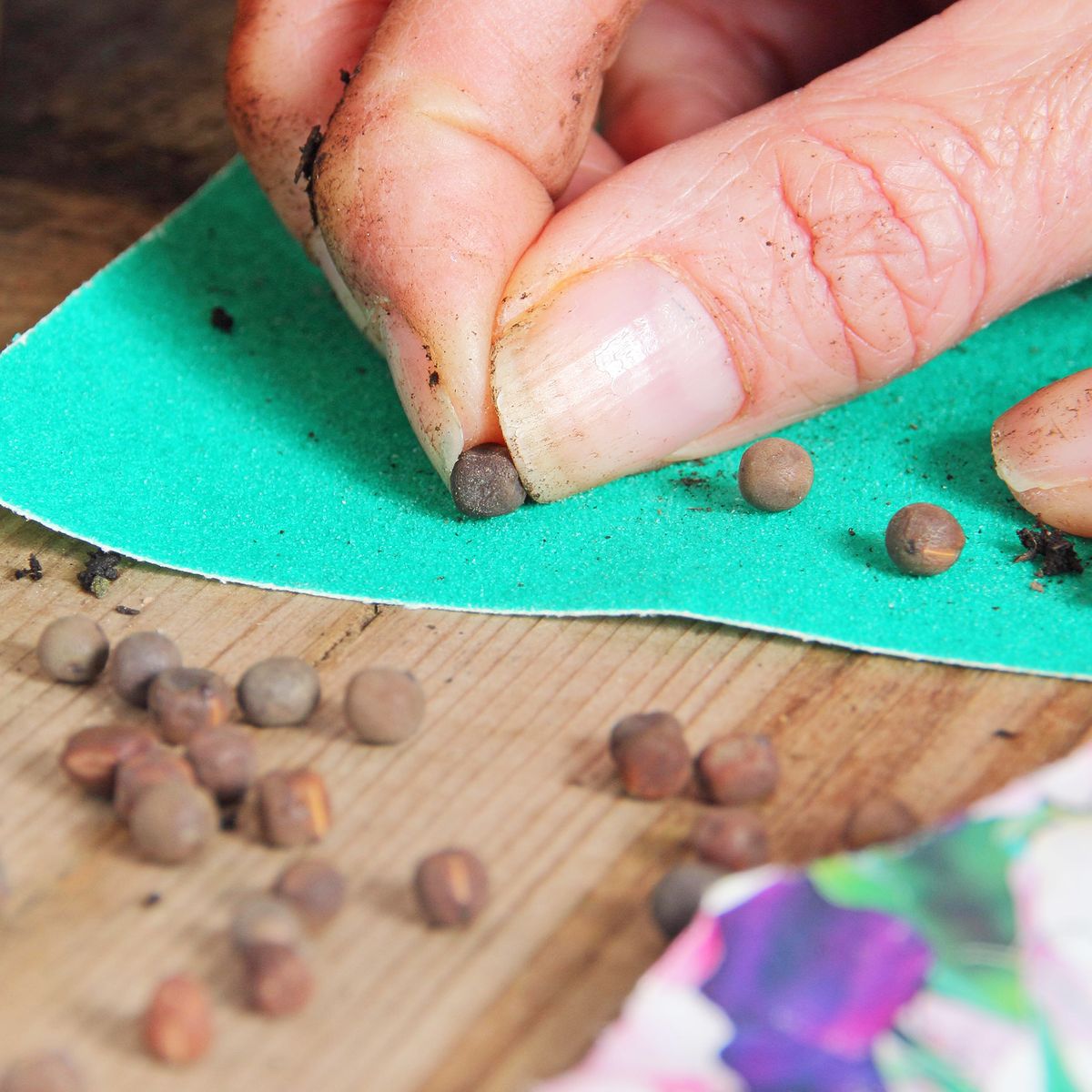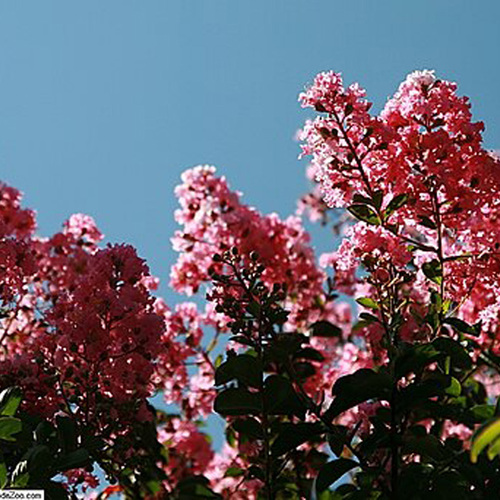Today we’re in central Indiana visiting with John Chapin, who has been gardening for over 45 years.
Our four acres of property was just a field of weeds with a small, seasonal creek when we bought it to build our house forty years ago. Most of the land we’ve planted with native trees, including sugar maples, river birch, bald cypress, and white pine, which have matured to provide excellent habitat for wildlife. We have landscaped about a half-acre around the house with a wide assortment of unusual trees, shrubs, and perennials. I always plant for plenty of winter interest. Bright and colorful foliage, twigs, and bark brighten up the dreariest of winter days.
 Winterberry (Ilex verticillata ‘Red Sprite’, Zones 3–9) berries make quite a show, until the birds gobble them up by the first of the year. I appreciate that these shrubs don’t mind damp areas.
Winterberry (Ilex verticillata ‘Red Sprite’, Zones 3–9) berries make quite a show, until the birds gobble them up by the first of the year. I appreciate that these shrubs don’t mind damp areas.
 The striking redtwig dogwood (Cornus sericea ‘Cardinal’ Zones 3–7), which I prune to the ground every spring to always have the most colorful stems the following winter.
The striking redtwig dogwood (Cornus sericea ‘Cardinal’ Zones 3–7), which I prune to the ground every spring to always have the most colorful stems the following winter.
 Conifers add so much interest to landscapes, both in form and color; I especially appreciate that in the winter. This weeping hemlock (Tsuga canadensis ‘Pendula’, Zones 3–7) becomes even more sculptural with a blanket of snow.
Conifers add so much interest to landscapes, both in form and color; I especially appreciate that in the winter. This weeping hemlock (Tsuga canadensis ‘Pendula’, Zones 3–7) becomes even more sculptural with a blanket of snow.
 A recent welcome addition to the gardens is a golden dwarf variety of Caucasian spruce (Picea orientalis ‘Firefly’, Zones 4–7), which shines in the winter garden. This is a sport of the much larger–growing ‘Skylands’, making it better suited for most gardens.
A recent welcome addition to the gardens is a golden dwarf variety of Caucasian spruce (Picea orientalis ‘Firefly’, Zones 4–7), which shines in the winter garden. This is a sport of the much larger–growing ‘Skylands’, making it better suited for most gardens.
 Stacked rocks, accented with snow, make interesting sculptures in the winter garden. To the surprise of visitors, these are not mortared together but are carefully balanced and surprisingly stable.
Stacked rocks, accented with snow, make interesting sculptures in the winter garden. To the surprise of visitors, these are not mortared together but are carefully balanced and surprisingly stable.
 The exfoliating bark of river birch (Betula nigra ‘Heritage’, Zones 4–9) never fails to impress. River birches are messy but are valuable, fast-growing native trees to naturalize wet areas.
The exfoliating bark of river birch (Betula nigra ‘Heritage’, Zones 4–9) never fails to impress. River birches are messy but are valuable, fast-growing native trees to naturalize wet areas.
 One of our most cherished trees, which literally shines in the winter landscape, is the hardiest variety of southern magnolia (Magnolia grandiflora ‘Bracken’s Brown Beauty, Zones 6–10). The glossy, evergreen leaves really stand out. Only the most severe winter will cause the leaves to wither and drop, but they are always replaced with fresh spring growth.
One of our most cherished trees, which literally shines in the winter landscape, is the hardiest variety of southern magnolia (Magnolia grandiflora ‘Bracken’s Brown Beauty, Zones 6–10). The glossy, evergreen leaves really stand out. Only the most severe winter will cause the leaves to wither and drop, but they are always replaced with fresh spring growth.
 I really love the variegated varieties of blue holly. This hardy holly (Ilex × meserveae ‘Honey Maid’, Zones 5–7) looks great in planters over the winter. Then when planted in the gardens along with a male pollinator to ensure berry set, it provides cut branches when larger.
I really love the variegated varieties of blue holly. This hardy holly (Ilex × meserveae ‘Honey Maid’, Zones 5–7) looks great in planters over the winter. Then when planted in the gardens along with a male pollinator to ensure berry set, it provides cut branches when larger.
 No matter how dreary the winter, gardeners can always depend on hellebores (Helleborus orientalis ‘Royal Heritage’, Zones 6–9) to be harbingers of spring. Mine bloom as early as late January, and even cold temps and snow rarely slow them down.
No matter how dreary the winter, gardeners can always depend on hellebores (Helleborus orientalis ‘Royal Heritage’, Zones 6–9) to be harbingers of spring. Mine bloom as early as late January, and even cold temps and snow rarely slow them down.
 Native witch hazels are truly amazing shrubs. I prefer the spring-blooming species (Hamamelis vernalis, Zones 4–8), which is the very earliest of flowering shrubs in our area, often blooming in January during mild winters. The plentiful, fragrant flowers’ ribbonlike petals unfurl on mild, sunny days but will curl up safely if temperatures fall below freezing, unfurling again when warmth returns. The flowers can last for several weeks, and I am always amazed to see plenty of honeybees enjoying this very early source of nectar.
Native witch hazels are truly amazing shrubs. I prefer the spring-blooming species (Hamamelis vernalis, Zones 4–8), which is the very earliest of flowering shrubs in our area, often blooming in January during mild winters. The plentiful, fragrant flowers’ ribbonlike petals unfurl on mild, sunny days but will curl up safely if temperatures fall below freezing, unfurling again when warmth returns. The flowers can last for several weeks, and I am always amazed to see plenty of honeybees enjoying this very early source of nectar.
Have a garden you’d like to share?
Have photos to share? We’d love to see your garden, a particular collection of plants you love, or a wonderful garden you had the chance to visit!
To submit, send 5-10 photos to [email protected] along with some information about the plants in the pictures and where you took the photos. We’d love to hear where you are located, how long you’ve been gardening, successes you are proud of, failures you learned from, hopes for the future, favorite plants, or funny stories from your garden.
If you want to send photos in separate emails to the GPOD email box that is just fine.
Have a mobile phone? Tag your photos on Facebook, Instagram or Twitter with #FineGardening!
You don’t have to be a professional garden photographer – check out our garden photography tips!
Do you receive the GPOD by email yet? Sign up here.
Get our latest tips, how-to articles, and instructional videos sent to your inbox.










